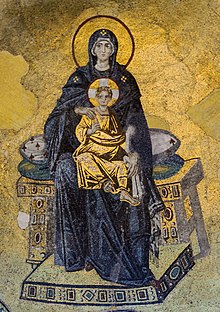Madonna enthroned
The Madonna (Greek Νικοποια (. Nikopoia , including: Nikopea , Nikopeia , Nicopeia ) that "victory bringer" the Mother of God ) is in the Byzantine iconography a certain type of Marie image , which in the West until the 13th century the most important autonomous Marienbild has been.
The name
The name Nicopoia is said to go back to the fact that a Byzantine ruler named Nikephoros ( accustomed to victory ) carried an image of grace designed in this way on his campaigns.
iconography

The Mother of God is represented as basilissa or empress sitting on a throne with lush cushions, with the baby Jesus on her lap. Her right hand is on the shoulder of the baby Jesus, the left on his knee. While the child's right hand is raised in blessing, the child's left hand (less common in early pictures) holds the scroll, symbol of power. The solemnity is represented by the frontal statics of mother and son on the same vertical axis.
In the Byzantine era, the Madonna's clothing followed rigid patterns. The hair was covered by a white cap. She herself was dressed in a red tunic and over it a blue coat, sometimes embroidered with three stars, and wore red shoes or slippers. This way of depicting the Madonna would become the most successful and widespread in Italy in the centuries that followed.
Mary's divine motherhood is attested in more recent depictions by two abbreviations on both sides of the head: "MP ΘY", for "Μητέρα του Θεού" (Mother of God).
This form of representation can be found
- in Byzantine times (4th - 15th centuries) as Maria lactans ("breastfeeding mother of God", Greek Galactotrophousa , "blessed womb")
- from the Romanesque (in Italy from the 13th century) as Sedes sapientiae ("seat of wisdom"), or as Maestà ("ruler") surrounded by angels or saints
- in the Renaissance of Italy (15th - 16th centuries) in the form of the Sacra conversazione ("holy conversation"), surrounded by saints
- the Baroque of the Counter-Reformation (17th-18th century) then again as Regina Coeli ( "Queen of Heaven"),
the latter two also as standing Madonnas.
Sedes sapientiae; Lorenzo Monaco : central panel of the Monte Oliveto altar (around 1410)
Giovanni Bellini : Pala di San Giobbe (Sacra Conversazione), Venice, 1487–88, Gallerie dell'Accademia , Venice
Mary Queen of Heaven, master of the Lucia legend , around 1485 to 1500
variant
A variant of Nicopoia is the Kyriotissa (Greek "Mother of the Lord"), a Byzantine Madonna image type in which Mary stands upright and presses the baby Jesus to her breast.
Iconographic story
This “triumphant type” prevailed in 431 after the Council of Ephesus . The prototype appears to be of Byzantine origin, as this iconographic type can be found in all areas where Byzantine art was able to gain a foothold. It can be found in Syria , Cappadocia , Egypt , Carthage , Italy , Russia , Romania and Bulgaria .
Among the 6th century icons there are only two preserved in good condition, one in the Monastery of St. Catherine in Sinai in Egypt and the other, called Madonna della Clemenza, in the Chiesa Santa Maria in Trastevere in Rome. In both depictions Mary is shown as the queen of angels and saints.
Maria as Nicopoia with the baby Jesus on her lap on a jeweled throne, surrounded by the archangels Gabriel and Michael and the martyrs Georg and Theodor in the Catherine's monastery
Mary as Basilissa with the baby Jesus on her lap sitting on a jeweled throne, surrounded by two guardian angels
Since the reign of Justinian I (527-565), one finds the type of Sophia in Constantinople Opel , in the Basilica of Sant'Apollinare Nuovo in Ravenna , etc.
Donor mosaic, 11th century. Maria as Nicopoia, surrounded by the church donor Emperor Justinian with the model of Hagia Sophia and by Emperor Constantine as the city founder with the model of Constantinople
After the iconoclastic battles under Leo III. and Constantine V , the role of Mary as mother of Jesus was reinforced with the Second Council of Nicaea (787). She should have the same role as her son, King of Christians. Sitting on the throne as queen, she was given the place of honor in the hemisphere of the central apse of the churches.
The Theotokos Nicopoia with the baby Jesus on her lap between angels, apse in the Hagios Demetrios church in Thessaloniki
Nicopoia with the baby Jesus, surrounded by angels and martyrs, the bishop Euphrasius and the deacon, apse in the in the Euphrasian basilica in Poreč
See also
literature
- Lorenzo Ceolin: L'iconografia dell'immagine della madonna . Storia e Letteratura, Rome 2005, ISBN 88-8498-155-7 , p. 61 (Italian, online version (preview) in Google Book search).
- Heinrich and Margarethe Schmidt: The forgotten visual language of art . CH Beck, Munich 1981, ISBN 978-3-406-54768-3 , p. 203 ( online version (preview) in Google Book Search).
- Alfredo Tradigo: Icons and Saints of the Eastern Orthodox Church (Guide to Imagery) . Getty Trust Publications, Los Angeles 2008, ISBN 978-0-89236-845-7 , pp. 166 ff . (English, online version (preview) in the Google book search).
Web links
- Nicopoia. In: Beyars.com. Retrieved August 29, 2017 .
- Icone della Ss.ma Madre di Dio - Vergine in trono. Retrieved August 29, 2017 (Italian).













